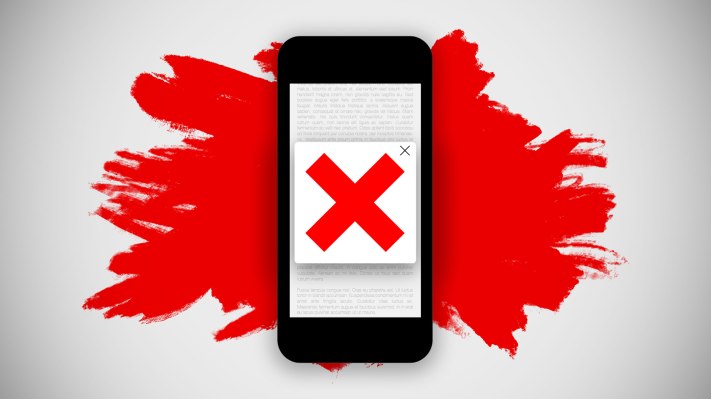Apple’s support for ad blockers on the new version of its mobile operating system, iOS 9, launching Wednesday, is poised to change how consumers interact with the web on mobile devices. Following the release, the Apple App Store will distribute applications that allow iPhone and iPad owners to install apps offering extensions for Apple’s Safari web browser that will prevent the browser from loading not just online ads and pop-ups, but also other content that slows down browsing and consumes resources. This includes tracking scripts, cookies, images, auto-play videos and more.
Trying to beat the newcomers to launch, ad-blocking giant AdBlock Plus recently released an ad-blocking web browser of its own. But, to be clear, this is a browser, not one of the new blockers. However, AdBlock will introduce an ad-blocking extension following iOS 9’s debut.
Meanwhile, ahead of iOS 9’s release, a number of companies and indie developers have been building content blockers of their own and testing them out with iOS 9’s sizable group of beta testers.
While many consumers will likely gravitate toward AdBlock Plus because of their familiarity with the brand’s name and reputation, there will be a good handful of new apps on the horizon as well, which are also worth a look.
Here are a few we’ve tried:
1Blocker
Like many of the content blockers in development, 1Blocker isn’t only focused on blocking ads. Instead, this app ships with 7,000 pre-installed blockers, including those affecting ads, tracking scripts and other items that run in the background on web pages, from ad networks and analytics providers.
The company claims that using 1Blocker decreased page loading times and total data downloaded by 50 percent, which means the app can help save battery life as well as cut down on your mobile data traffic (and therefore, your cell phone monthly bill).
To use the app, you first enable 1Blocker in Settings –> Safari –> Content Blockers on your device. This is the same area where all content blocking extensions have to be enabled.
[gallery ids="1208771,1208775,1208774,1208773,1208772,1208767,1208766"]
Afterwards, you can return to the app to customize your configurations even further. While there’s a big toggle switch to turn on or off 1Blocker using its default settings, what’s nice about this app is the ability to personalize the content it blocks – something not all the content blockers will do out of the gate.
In 1Blocker, you can toggle on and off switches for things like blocking Facebook widgets, Twitter widgets, Share Widgets, Custom web fonts, Disqus comments, ads, trackers, cookies and more. You can even block adult sites, or specify specific URLs or cookies using rules you create.
For those who understand things on a more technical level, you can create very narrowly targeted rules. For example, you can choose to block either first-party or third-party cookies on all domains, specific domains or only outside particular domains. And you can create URL filters using quantifying expressions (e.g. with *, ?, and +).
The app doesn’t just stop there, either. It also integrates with a web editor at my.1blocker.com which allows you to work on your own customizations via your desktop or laptop computer that you can then send to your phone. This allows for even deeper customizations and rule editing, as you’re able to take advantage of a more advanced editor to create rules and workflows that let you block content or cookies while turning off or on various resource types like documents, images, StyleSheets, fonts, SVG files, pop-ups and more.
You’ll also be able to open rule packages created and saved by yourself or others from a file on your computer and then import them to your iOS device by selecting 1Blocker from the “Open In” menu.
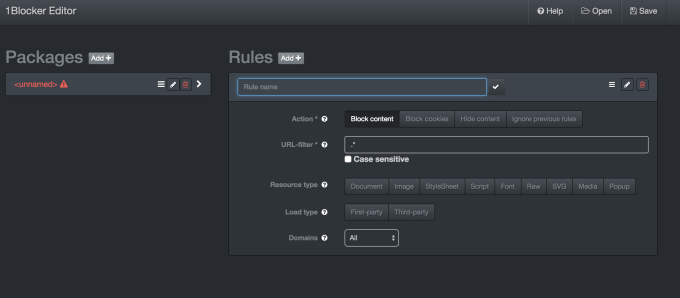
This allows you to personalize what’s being blocked very specifically, explains indie developer Salavat Khanov who built the 1Blocker app. “Using 1Blocker you could create a custom blocker to block all GIFs on Tumblr,” he offers as an example. “It lets you block any resources on the web, hide particular elements on pages – like comments on Hacker News – or block 1st or 3rd party cookies on all or specific list of domains.”
In tests, across of a number of news sites including The WSJ, Wired, Mashable, The Verge, NYT, Ars Technica, Slashdot, Vice (Motherboard), ZDNet and several others, 1Blocker saved 49.85 percent data from being loaded. At the top of the list, Business Insider (UK) saw 84.53 percent of data saved, PCGamer saw 82.78 percent saved, and iMore saw 82.28 percent data saved, to give you an idea.
Best For: More technical users who want a customized content blocking experience and want to create their own rules.
Pricing: Free version will allow one group of blockers (e.g. “Block Ads” or “Block Trackers”). To unlock other groups of blockers, there will be an in-app purchase of $2.99.
Blockr
Another new content blocking extension, Blockr, has also been in testing ahead of the iOS 9 launch. Similar to 1Blocker, you are able to customize what’s being blocked to some extent, though this app has far less detail to it.
Instead of being presented with a longer list of content types to turn on or off, or creating your own advanced rules, Blockr takes a more simplified approach to customizations. On the app’s main screen, you can choose only to turn on or off a handful of settings, including ads, media, tracking mechanisms and cookie policy warnings.
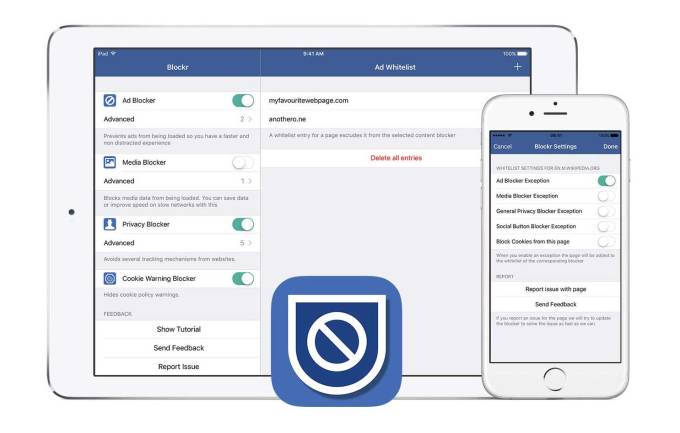
For more novice users, this type of interface offers some level of control over your browsing experience without becoming too technical. Each option briefly explains why you may want to enable this setting. For example, the Media Blocker setting says that by blocking media you can “save on data or improve speed on slow networks,” while the privacy blocker notes that this helps you avoid “several tracking mechanisms from websites.”
However, while you’re able to turn off or on these various settings by flipping a switch, you can’t drill down to specify things like which types of media to block (e.g. images vs. auto-play videos), or which ad networks to block (1Blocker offers toggles for each one supported), nor can you configure blocking for specific things like social share widgets.
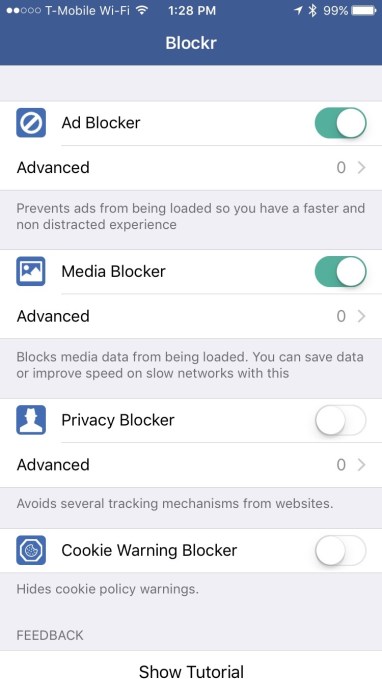
The customization in Blockr is limited to allowing you to whitelist certain websites from having their content blocked. It’s not a universal whitelist, though – you have to whitelist the site on each setting.
Blockr was built by German developers Tim Poller and Arno Appenzeller, who tell us their app will offer more types of blockers in the future, as they plan to support the app long-term.
Best For: Those who want some level of customization in terms of toggling ads, content, or tracking script blocking on or off, but don’t need to create highly customized rules.
Pricing: The app will be a paid download for $0.99 at launch. Following the promotion, the price will increase to $1.99.
Crystal
Crystal is an upcoming content blocker that’s seen a bit of pre-launch press thanks to creator Dean Murphy’s blog which has been sharing the results of various tests of its effectiveness during beta trials. For example, after testing Crystal against 10 popular websites, Murphy found that pages loaded 3.9x faster on average, and used 53 percent less data.
However, unlike the above two blockers, Crystal doesn’t offer any customizations.
According to Murphy, that choice is by design, he says. “[Crystal is] designed to be simple and unobtrusive,” Murphy explains. “You just turn it on and all ads and tracking is blocked by default. The app is kind of just a shell, as its secondary features – auto-update and report site features – work in the background or via the Safari Action Extension menu.”
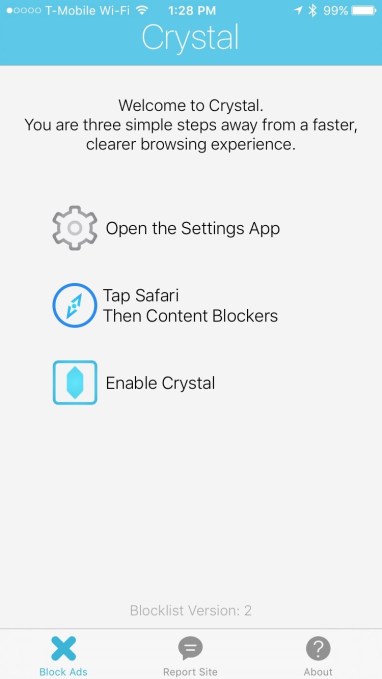
“Report site,” to clarify, is a feature that will tap Crystal’s own user base to help the app get better at blocking. If you come across a website that’s still showing ads (or has stopped working because of the blocking, perhaps), you can submit the URL directly to the app’s developer. You won’t have to turn Crystal off to get around a broken site, of course – in iOS 9, you can hold down the refresh button in Safari and choose “reload without content blockers” whenever you run into trouble with any of these extensions.
While Crystal’s focus will be on offering users a sort of “set-it-and-forget-it” experience, Murphy says that he will introduce a whitelist feature to allow users to specify domains they don’t want blocked. He notes he’s also exploring a couple of other features, too, but declined to share what those are for the time being.
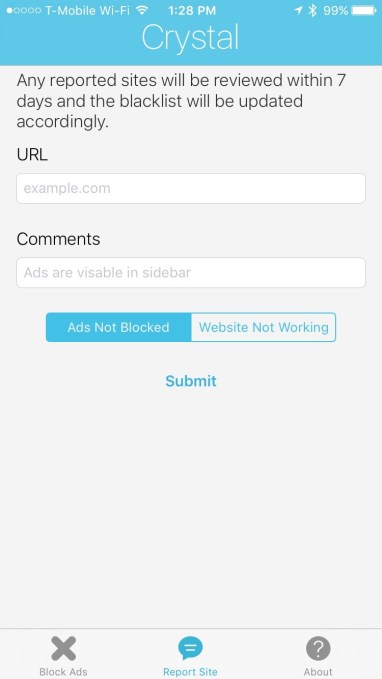
Best For: Novice users who just want to turn on content blocking without having to worry with the details.
Pricing: TBD, but Crystal will be a premium app.
